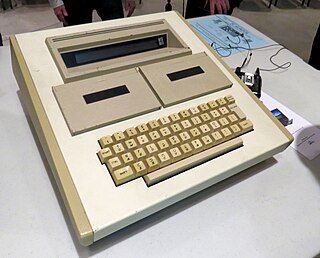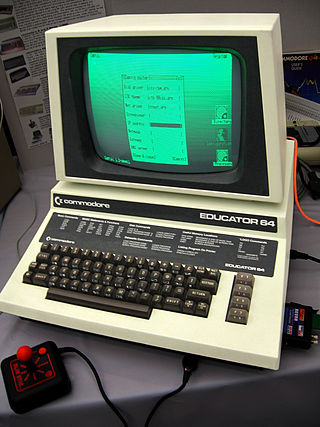
QNX is a commercial Unix-like real-time operating system, aimed primarily at the embedded systems market.
NAPLPS is a graphics language for use originally with videotex and teletext services. NAPLPS was developed from the Telidon system developed in Canada, with a small number of additions from AT&T Corporation. The basics of NAPLPS were later used as the basis for several other microcomputer-based graphics systems.
Watcom International Corporation was a software company, which was founded in 1981 by Wes Graham and Ian McPhee. Founding staff were formerly members of Professor Graham's Computer Systems Group at the University of Waterloo, in Waterloo, Ontario, Canada. Watcom produced a variety of tools, including the well-known Watcom C/C++ compiler introduced in 1988.
Educational software is a term used for any computer software that is made for an educational purpose. It encompasses different ranges from language learning software to classroom management software to reference software. The purpose of all this software is to make some part of education more effective and efficient.

Compis was a computer system intended for the general educational system in Sweden and sold to Swedish schools beginning in 1984 through the distributor Esselte Studium, who also was responsible for the software packages.

The MCM/70 is a pioneering microcomputer first built in 1973 in Toronto, Ontario, Canada and released the next year. This makes it one of the first microcomputers in the world, the second to be shipped in completed form, and the first portable computer. The MCM/70 was the product of Micro Computer Machines, one of three related companies set up in Toronto in 1971 by Mers Kutt. It is considered by some historians to be the first usable personal microcomputer system.
The Minnesota Educational Computing Consortium, most commonly known as MECC, was an organization founded in 1973 best known for developing the edutainment video game series The Oregon Trail and its spinoffs. The goal of the organization was to coordinate and provide computer services to schools in the state of Minnesota; however, its software eventually became popular in schools around the world. MECC had its headquarters in the Brookdale Corporate Center in Brooklyn Center, Minnesota. It was acquired by SoftKey in 1995 and was shut down in 1999.
PL/M, an acronym for Programming Language for Microcomputers, is a high-level language conceived and developed by Gary Kildall in 1973 for Hank Smith at Intel for the Intel 8008. It was later expanded for the newer Intel 8080.
The Acorn Business Computer (ABC) was a series of microcomputers announced at the end of 1983 by the British company Acorn Computers. The series of eight computers was aimed at the business, research and further education markets. Demonstrated at the Personal Computer World Show in September 1984, having been under development for "about a year" and having been undergoing field trials from May 1984, the range "understandably attracted a great deal of attention" and was favourably received by some commentators. The official launch of the range was scheduled for January 1985.
Eastview Secondary School is a public secondary school located in northeastern Barrie, Ontario, Canada. It has an enrollment of about 1,400 students.
RM Nimbus was a range of personal computers from British company Research Machines sold from 1985 until the early 1990s, after which the designation Nimbus was discontinued. The first of these computers, the RM Nimbus PC-186, was not IBM PC compatible, but its successors the PC-286 and PC-386 were. RM computers were predominantly sold to schools and colleges in the United Kingdom for use as LAN workstations in classrooms.

Crosscountry is a series of educational video games for North American students. The games are published by Ingenuity Works, a Vancouver-based company originally known as Didatech Software.

The Educator 64, also known as the PET 64 and Model 4064, was a microcomputer made by Commodore Business Machines in 1983. It was sold to schools as a replacement for aging Commodore PET systems. Schools were reluctant to adopt the Commodore 64 "breadbox" design due to theft or vandalism of the smaller, more exposed components. The 4064 designation followed in line with the PET's 4008, 4016 and 4032 models as a 64 KB 40-column model.

The history of the personal computer as a mass-market consumer electronic device began with the microcomputer revolution of the 1970s. A personal computer is one intended for interactive individual use, as opposed to a mainframe computer where the end user's requests are filtered through operating staff, or a time-sharing system in which one large processor is shared by many individuals. After the development of the microprocessor, individual personal computers were low enough in cost that they eventually became affordable consumer goods. Early personal computers – generally called microcomputers – were sold often in electronic kit form and in limited numbers, and were of interest mostly to hobbyists and technicians.

The BBC Microcomputer System, or BBC Micro, is a series of microcomputers designed and built by Acorn Computers Limited in the 1980s for the Computer Literacy Project of the BBC. The machine was the focus of a number of educational BBC TV programmes on computer literacy, starting with The Computer Programme in 1982, followed by Making the Most of the Micro, Computers in Control in 1983, and finally Micro Live in 1985.

Home computers were a class of microcomputers that entered the market in 1977 and became common during the 1980s. They were marketed to consumers as affordable and accessible computers that, for the first time, were intended for the use of a single, non-technical user. These computers were a distinct market segment that typically cost much less than business, scientific, or engineering-oriented computers of the time, such as those running CP/M or the IBM PC, and were generally less powerful in terms of memory and expandability. However, a home computer often had better graphics and sound than contemporary business computers. Their most common uses were word processing, playing video games, and programming.
The following outline is provided as an overview of and topical guide to computing:

Computers can be classified, or typed, in many ways. Some common classifications of computers are given below.
Peter R. Jennings is a British-Canadian physicist, scientist, inventor, software developer, computer chess programmer, and entrepreneur. He is most notable for creating MicroChess, the first microcomputer game to be sold commercially.








